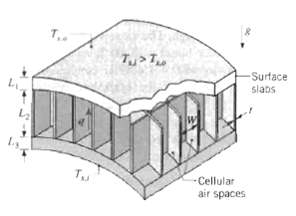Question: The composite insulation shown, which was described in Chapter 1 (Problem 1.72e), is being considered as a ceiling material. It is proposed that the outer
The composite insulation shown, which was described in Chapter 1 (Problem 1.72e), is being considered as a ceiling material. It is proposed that the outer and inner slabs be made from low-density particle board of thicknesses L, = L3 = 12.5 mm and that the honeycomb core be constructed from a high-density particle board. The square cells of the core are to have length L2 = 50 mm, width W = 10 mm, and wall thickness t = 2 mm. The emissivity of both particle boards is approximately 0.85, and the honeycomb cells are filled with air at 1-atm pressure. To assess the effectiveness of the insulation, its total thermal resistance must be evaluated under representative operating conditions for which the bottom (inner) surface temperature is Ts, i = 25?C and the top (outer) surface temperature is Ts, o = - 10? C. To assess the effect of free convection in the air space, assume a cell temperature difference of 20? C and evaluate air properties at 7.5? C. To assess the effect of radiation across the air space, assume inner surface temperatures of the outer and inner slabs to be -5 and 15?C, respectively.

T>T Surface slabs Cellular air spaces
Step by Step Solution
3.33 Rating (171 Votes )
There are 3 Steps involved in it
KNOWN Dimensions of a composite insulation consisting of honeycomb core sandwiched between solid slabs FIND Total thermal resistance SCHEMATIC Because of the repetitive nature of the honeycomb core th... View full answer

Get step-by-step solutions from verified subject matter experts
Document Format (1 attachment)
8-E-M-E-H-M-T (1323).docx
120 KBs Word File


